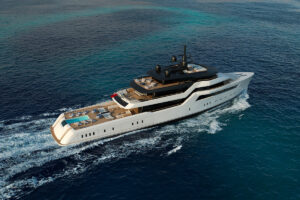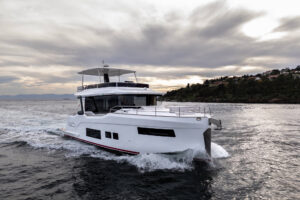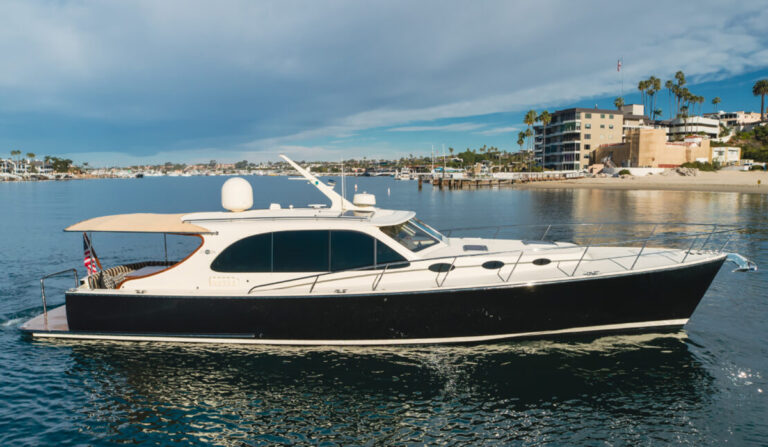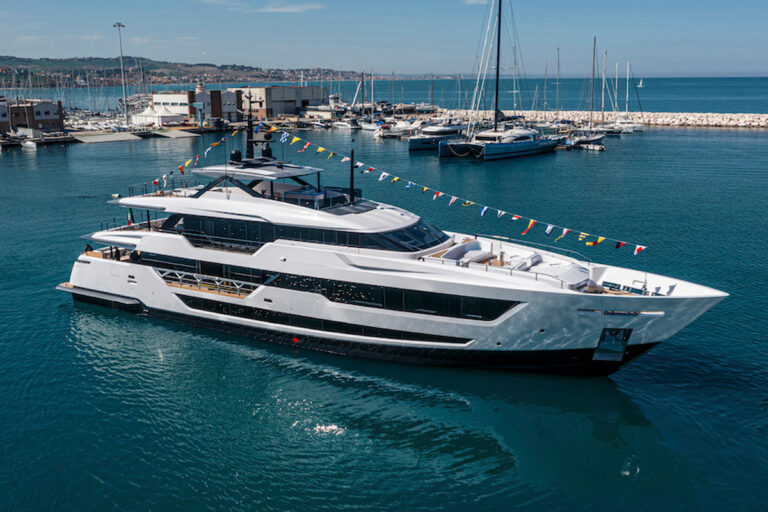
Top down, like on a convertible sports car: the Sunseeker has a roll-away sunroof and packs plenty of performance, thanks to twin 1,550 hp man diesels.
In calm conditions there usually are not too many problems with a sea trial. When the weather is less than favorable, though, it’s a different story. That’s when you can sense the tension: The builder wants to impress, yet isn’t quite ready to let his newborn out in adverse conditions.
On the day I was to take out the new Predator 72, there were strong winds and rough seas, but strangely enough, the folks at Sunseeker didn’t seem to mind. The boatyard’s location in Poole, England, allowed us to find sheltered waters for the first part of the trial. As confidence built, we could peek out and see the rougher seas.
As we nosed farther and farther out, I kept waiting to feel the 72 balk. But at sea the handling was everything you’d expect from a Sunseeker: sharp and taut even though the spray was flying. I loved the precise way this hull coped with the oncoming waves, cutting through the crests and riding very level and true. The hand on the throttle needs to be sensitive to changing conditions, but that is part of the joy of driving a pedigree boat. There also is some harshness from the chines at speed, but this is very much the sport-boat feel that makes the design attractive.
Sunseeker was one of the first yacht builders to find a way to combine high performance and luxury in the genre that is now known as the sports cruiser. The company has been raising the style stakes for the past 10 years, constantly refining its concept. And Sunseeker has been successful at this. Throughout development, the Predator range retained a freshness and excitement that has made it the standard by which the others are judged.
Since the early Sunseekers, the style has evolved into more and more exuberant designs emphasizing compound curves and exciting contours. It was the move up into the flagship Predator 108 that saw a return to a more conservative design and this new approach is evident in this latest 72.
To many builders these days focus on what goes on above the waterline without giving detailed thought about the technicalities. The race-bred hull of the 72 is a pure deep-V with an 18-degree deadrise. This is deep enough to cushion the ride in waves but shallow enough not to compromise the performance. Spray rails help to keep the water under control and the powerful chines contribute to the stability and the easy planing of the hull. The dynamic lines start at the steep rake of the bow and end with a wide swim platform at the stern. This platform also acts as a hydraulic lift for the tender.
In harbor the 72 is remarkably docile, so that a couple can easily handle it, with the bowthruster giving a captain an extra boost of confidence in tight quarters. (Maybe that crew-quarters option is not absolutely essential.)
The twin 1,550 hp MAN diesels are the top of the range and can kick it up to 38 knots-pretty impressive when you take into account the conventional shaft and propeller propulsion. You’ll lose about two knots from this top line if you specify the smaller 1,360 hp MAN diesels, although both of these options provide an economical cruising speed of 25 knots. The propellers are recessed into semi-tunnels at the stern to reduce the shaft angle and to improve efficiency.
The large cockpit explains why these boats are called “sunseekers: There are sunbeds, settees and a table for open-air dining, plus a wet bar for drinks. Beneath the aft sunbed lies a tender garage, offering several options. The standard garage is large enough for a compact tender; the penalty for the optional larger garage comes in the form of reduced space in the cockpit, meaning a little less “sunseeking. The third option in this stern area is for a crew quarters across the transom.
Another sunbed up on the foredeck provides even more outdoor social space and, again living up to her name, there is a large sunroof fitted to the wheelhouse. This converts the whole deck saloon into an open space when it is rolled back, flooding the saloon with light. Here you can also enjoy open-air dining under the stars around the saloon table, which has generous and very comfy seating. Behind the helm seats there is a bar and barbecue, plus an entertainment center with the latest in equipment.
This is the fun-and-sun side of the Sunseeker, but let’s not forget the serious side: driving this performance yacht. Up front there is good and secure seating for four, so both guests and the driver can enjoy the ride. The impressive display of instruments at the helm provides all the information you need for navigating, flanked by engine and autopilot displays. The deep windscreen pillars do restrict the visibility from the helm to a certain extent, but otherwise this is very much a driver’s boat-you can sit back, enjoy the fast ride yet feel in control of the situation.
The standard layout is conventional and includes the master stateroom amidships, the VIP double cabin forward and a two-berth cabin on the starboard side. Between the cabins is a compact saloon or breakfast room and the galley, the latter having direct access to the deck saloon via the adjacent stairs. If having a maximum number of berths on board is your priority, however, then you are likely to go for the four-cabin option. Here, the lower saloon area is converted into a Pullman cabin with two bunk beds.
The galley is down below, which may not be to everybody’s taste, but there is the barbecue grill on the upper saloon for alfresco meals. This is one of those compromises that have to be made when combining the requirements of high performance with luxury accommodations. The two double staterooms are downright sumptuous with their rich cherry-wood paneling and fine fabrics. The same theme is echoed in the saloon, with more light and air from the large windows. The teak deck is a practical solution for a practical yet luxurious motoryacht.
Sunseeker has allowed generous room within the engine compartment. It is easy to move around down here and servicing should not present any problems, although the garage or the crew-quarters option will obviously intrude on this space.
Sunseeker has found an excellent balance in this new design. As owners demand more and more from modern power yacht designs, it gets harder and harder for a designer to find the right balance of compromises. Matching up the requirements of what is virtually a sports boat with the luxury that owners now expect when in harbor is not easy, but in this 72 the balance looks good-speed and beauty without too much compromise.
Contact: Sunseeker International; www.sunseeker.com









